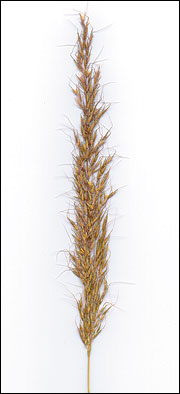Indiangrass (Sorghastrum nutans (L.) Nash)
Warm-season grasses
Indiangrass is a native, perennial warm-season grass with a number of uses, from a forage crop to conservation and wildlife habitat. Indiangrass can grow throughout the state, but it is best grown in mixtures with other native warm-season grasses. It matures two or three weeks later than big bluestem, and because it does not begin reproductive growth until later in the season, it can be of high quality both as pasture and hay. However, Indiangrass has trouble establishing itself without proper weed control and does not grow well in poorly drained areas. Its weaknesses are that it does not produce abundant forage until late in the season and has poor regrowth potential.
 Indiangrass
Indiangrass
 Yield distribution of Indiangrass in Missouri.
Yield distribution of Indiangrass in Missouri.
- Origin: North America
- Adaptation to Missouri: Statewide
- Growth habit: Tall, rhizomatous, perennial bunchgrass.
- Blade: Flat, pointed, narrower base, often glaucous, prominent midrib near base.
- Sheath: Smooth, rounded to flat, upper shorter than the internodes, usually glabrous.
- Ligule: Membranous, thick, stiff, about 1/10 inch long, flanked by pointed auricles.
- Auricles: Prominent “rabbit ear” auricles.
- Seed head: Narrow, oblong panicles, large, dense and bronze-yellow.
- Fertilization: 40 to 60 lb N/ acre in spring when grass is 3 to 5 inches tall. Phosphorus and potassium to soil test.
- Burning management: Every year or two, when new growth is 1 to 2 inches tall.
- Timing of production: Produces 70 percent of its growth between July 1 and Aug. 31, two to three weeks later than big bluestem.
- When to begin grazing: When grass is 12 inches tall.
- When to cut for hay: Early boot stage
- Lowest cutting or grazing height: 6 inches
- Fall management: Do not hay or graze after Sept. 1.

